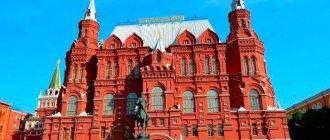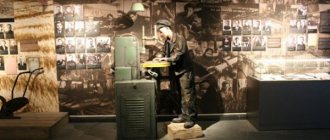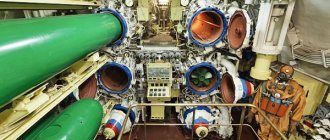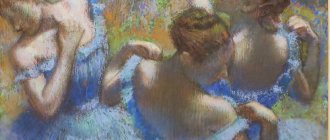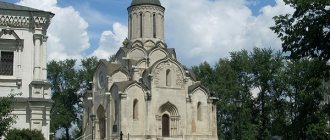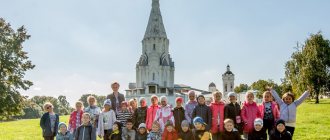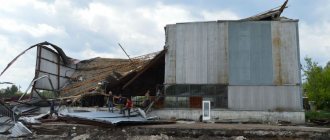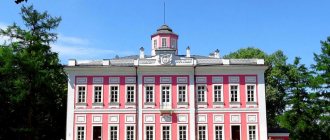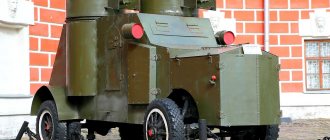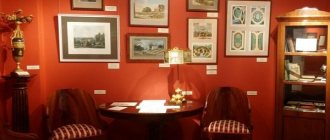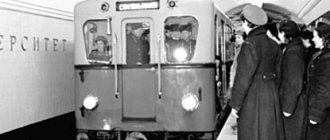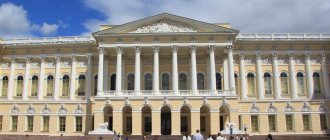History of the museum
An industrial exhibition dedicated to the 200th anniversary of the birth of the first Russian emperor - at which trophies brought from the Crimean War were also exhibited - was the impetus for the implementation of an idea that had been discussed for several years in the circles of the learned nobility. Count Uvarov A.S. proposed organizing an exhibition about the life of the people before Peter I in drawings.
Tsarevich Alexander, having visited Denmark and the museum of antiquity in the former residence of the king, was inspired by the idea of founding something similar in Russia, and upon his return he began to seriously engage in archaeological research.
Major General Nikolai Chepelevsky, who gave public lectures on the defense of Sevastopol, also for many years nurtured the idea of organizing a place where not only exhibition exhibits would be stored, but also work would constantly be carried out to collect new material. In January 1872, at one of the receptions, Tsarevich Alexander received a note from Chepelevsky with a request to establish a gallery.
The Grand Duke was enthusiastic about the idea of building such a place, which everyone could visit and make sure that it was not yesterday that Homo sapiens appeared on Russian soil. In February, Alexander Alexandrovich submitted a petition to the emperor, who issued a decree on the founding of the museum.
At the direction of Alexander II, a committee was organized, headed by Uvarov. The commission included outstanding historians such as Vasily Klyuchevsky, Ivan Zabelin, Dmitry Ilovaisky. Alexey Sergeevich Uvarov developed and presented the Museum Charter in August 1874, where he streamlined all aspects related to the expansion of the fund and storage of exhibits.
At the beginning of 1875, the committee announced the terms of the competition for architects to design the construction of the museum building. The future museum was planned in the early Russian style and was supposed to complement the overall architectural composition.
In August of the same year, the Fatherland project, developed by Sherwood and Semyonov, was adopted. The well-developed construction plan was reinforced with various explanations and amazed the commission members with the thoroughness and strength of their knowledge of Russian architecture.
When starting to develop the construction of the museum, Uvarov and his assistants believed that it would be a public place built with charitable donations. But the fundraising failed, and they had to take out a loan of more than a million rubles.
Museum concept
The State Historical Museum, a year after the signing of the decree on its creation, defined the central concept - to show visitors the history of the homeland in the main eras.
Although disagreements did not stop until construction was completed: Uvarov and Zabelin argued that the key element of the exhibition should be authentic exhibits; Sherwood recommended also presenting paintings and other works by contemporaries on historical themes. Chepelevsky proposed dedicating the main exhibition to military glory.
Construction
The ceremonial laying of the first stone took place on September 1, 1875, the emperor was personally present at the ceremony. Initially, it was supposed to be built near the Kremlin wall, but in April 1874, the scientific commission received the territory where the Zemstvo Prikaz had previously been located for the State Historical Museum.
Laying the foundation of the State Historical Museum
Construction lasted 6 years. In 1879, construction was suspended due to lack of finances, but in 1881, after receiving a loan, the construction of the town hall was completed.
Architect and building architecture
Vladimir Sherwood developed the project for seven years, constantly changing and complementing the concept of architecture and exterior design. Sherwood especially paid attention to the facade facing St. Basil's Cathedral.
As planned, the general appearance of the building had to correspond to the style of Russian architecture: kokoshniks, flies, tents and other components would certainly be present. Vladimir Osipovich reworked the finished project four times until he developed the ideal option. In 1878, Sherwood stopped heading the construction; he was replaced in this post by A.P. Popov.
The internal layout of the State Historical Museum building was developed by Anatoly Aleksandrovich Semenov, a military engineer by training.
The construction was carried out innovatively - for the first time cement was used for masonry, floors were made of metal , and the town hall was also equipped with air ducts and drains. A.A. Semenov closely monitored the progress of the work and personally selected materials for construction. More than 250 masons and about 400 auxiliary workers worked under his leadership.
Alexander Protogenovich Popov completed the exterior and interior decoration of the building. He installed the heraldic symbols of the Romanovs on the towers, and placed double-headed eagles on 4 of them. The gilded sculptures are made according to his sketches in a special way, for a better view from Manezhnaya and Red Squares - they turn to the wind not with an edge, but with a wide side.
Also, the turrets of the State Historical Museum are decorated with gilded unicorns fighting lions. Under the leadership of Popov, artistic work was carried out in the premises. Famous artists Aivazovsky, Repin, Serov, Vasnetsov and others were invited to design it.
Interior
By the opening of the museum, 11 halls were fully equipped. Subsequent decoration was carried out over decades; now there are 40 exhibition halls. The entire architecture of the building and the internal design of the elements were copied from architectural monuments, temples and cathedrals that existed at the time of construction.
Initially, it was planned to decorate the rooms in the spirit of the eras, in accordance with the name and the exhibition exhibited in it. This idea was unique to the Russian Empire. The rooms inside the State Historical Museum follow each other in an enfilade style. The halls smoothly guide visitors chronologically - starting from the Paleolithic era and ending with modern history.
The doors were made specially in Polyakov’s workshops from pine and oak trees, and double display cases for exhibits were also made there. Artel Sedova provided craftsmen for mosaic work on the floors on the first floor. A.P. Popov developed the design of the windows; they look like the mica interlacing of ancient Russian towers and furniture. The premises of the State Historical Museum are decorated with arches, columns, unique stucco moldings and paintings.
The Grand Entrance Hall welcomes guests. The walls, painted in the Old Russian style, and two rows of columns along the edges of the hall form a corridor, the arches of which are decorated with the coats of arms of the 78 provinces that are part of the Russian Empire.
The Senya vault is decorated with a family tree containing 68 rulers, Rurikovich and Romanov. At the base are depicted Princess Olga and Prince Vladimir, and the family tree is completed by portraits of the imperial couple: Alexander III and Maria Feodorovna. The family tree does not fully reflect all the rulers who occupied the throne - it lists only those who made the greatest contribution to the history and development of Rus'.
The front entrance, which is rarely used today, is decorated with a carved wooden portal on the inside of the building. At the main staircase, made of Carrara marble, there are bronze lions holding shields with the monograms of Alexander II and Alexander III. Since 1875, the main ideological inspirers of the project, Uvarov and Zabelin, began collecting exhibits and cultural heritage items for exhibitions.
Count Uvarov searched for and acquired unique antiquities throughout the empire; they themselves made a significant contribution to the collection of personal property, and set an example for many noble families. Thus, the Obolenskys, Golitsyns, Kropotkins, and Shcherbatys were among the first to transfer part of the family valuables to the collection of the State Historical Museum.
In 1881, a few months after ascending the throne, Alexander III signed a decree on state funding for the museum. At the same time, the emperor appointed Count Uvarov as director and Prince Sergei Alexandrovich as chairman.
Museum opening
Since the finishing work was not completed, no official grand opening was held. At the end of May 1883, the august couple visited the museum for the first time. Having received the approval of Alexander III, the organizers invited the Metropolitan to consecrate the building, and on June 2 the museum opened to the general public. 11 finished halls represented Rus' from ancient times to the 13th century.
Uvarov died a year after the opening of the State Historical Museum and Zabelin became the de facto director.
At his insistence, in 1887 the Ministry of Finance allocated an annual subsidy of 10 thousand rubles to increase the museum fund and conduct research activities.
Under Zabelin, 10 more halls on the first floor were prepared and put into operation; in addition, Ivan Yegorovich regulated staff and financial affairs.
Until his death, in 1908, Zabelin was involved in organizational and legal issues, streamlining the life of the museum, collecting exhibits for the collection and research material.
Many famous families donated their collections to the museum for storage, so Turgenev’s widow donated all her husband’s manuscripts and materials. Many merchants, artists and scientists filled the collection of the State Historical Museum. The most remarkable gift was made by the merchant-philanthropist P.I. Shchukin, who donated his collection of more than 300 thousand exhibits.
In 1912, an exhibition was organized to commemorate the centenary of the victory over Napoleon. For its organization, exhibits were collected from all corners of the empire. Most of the items remained in the museum.
When designing, Sherwood did not expect that large storerooms would be needed, so already at the beginning of the 20th century the storehouses could not accommodate the museum’s huge collection. Many items were stored in improper conditions. This was one of the reasons to join the Town Hall of the City Duma and the Provincial Board to the State Historical Museum. The final decision was postponed due to the outbreak of the October Revolution.
History after the revolution
Since 1917, many of the museum's objects were at risk of being destroyed. The new government organized a special committee to identify and destroy anti-Soviet values.
However, during the first years of the Soviets, the collection of objects more than doubled, and continued to grow due to disbanded museums, destroyed churches and estates. Over the course of 5 years, the official name changed twice; in 1921, the museum was given the name – State Historical Museum.
Rallies and skirmishes regularly took place near the building. About the very first battle, between the Dvina revolutionaries and the cadets, there is a memorial plaque on the wall of the State Historical Museum.
Since 1922, branches began to be added to the museum, including the House of Boyar Life, St. Basil's Cathedral, Kolomenskoye Estate and other historical objects. The work of the museum was reoriented, scientists were forced to engage in communist propaganda.
In 1936, a decision was made to redesign the interior of the museum in honor of the 20th anniversary of the revolution. The architects were tasked with removing all the elements of Tsarist Russia, as a result of which the Main Entrance Hall and the halls dedicated to the reign and reign in Rus' were completely redone.
In Senya, the walls were completely repainted and the vaults were whitewashed, unique stucco moldings were broken off throughout the building, and heraldic symbols were removed from the towers and melted down. Many decorative elements have been lost forever.
Since 1937, the State Historical Museum again began to engage in scientific research. By this time, 28 exhibition rooms had been opened, covering history up to the 17th century.
Post-war years
Immediately after the start of the Great Patriotic War, the most valuable exhibits were transported, initially to the Volga, and then to Kazakhstan, where they remained until the victory. The gallery itself continued to work and during the entire period of the fight against fascism it closed its doors for 8 days only once - as a result of the bombing in the fall of 1941, a fault appeared at the base of the building and several window panes broke.
In 1942, hot on the heels, an exhibition opened, occupying 3 halls, dedicated to the siege of Moscow by Nazi Germany. In 1943, the exhibition already occupied 6 rooms and was dedicated to the resistance to the Germans from the reign of Yuri Dolgoruky to the present. More than 12 thousand items and war trophies, as well as letters and historical documents were collected during the war.
By 1957, rooms were opened on the second floor of the museum. The general exhibition covered the history of the Russian State from ancient times to 1917.
In 1963, the number of exhibition halls was already 37, most of the rooms on the second floor were used for thematic communist exhibitions. Research work was carried out, the museum was recognized as the largest museological center in the USSR.
History after the collapse of the USSR
In the early 80s, the question of restoration and reorganization of the State Historical Museum became acute; the building had not been updated for a hundred years. Every year there were about 15 accidents associated with disruption and wear and tear of communication networks.
In 1981, budget funds were allocated for the overhaul of the State Historical Museum. Over the next 5 years, the collection was transferred to branches, and in 1986 the museum was closed for restoration. However, activities were not stopped during the renovation - the management organized thematic exhibitions held in various cities in Russia and abroad.
Large-scale engineering and technical work was carried out in the building on Red Square, aimed primarily at improving the safety of ancient and valuable exhibits. Also, based on authentic records and documents, the interior decoration was restored to its original, pre-revolutionary appearance.
Some decorative elements were preserved and returned to their places; those that were irretrievably lost were made anew, guided by records from the archive. In 1997, the double-headed eagles were cast and installed again. The original figures of lions and unicorns were returned in 2002.
The State Historical Museum opened its doors to visitors in 1997 in the same form as originally projected. 8 exhibition and 3 exhibition halls were provided for excursions. At the beginning of the 21st century, the nearby buildings in which permanent exhibitions were organized were transferred to the ownership of the museum.
Exhibitions and excursions
Even if you have visited the State Historical Museum of Moscow more than once, something new will await you every time you visit. In addition to the permanent main exhibition, thematic exhibitions dedicated to the history of the royal family, traditional Russian crafts, photography, painting or the creation of icons are regularly opened here. For a live immersion in the past, museum staff organize “Historical Saturdays”, opening unknown pages of Russian history, “Moscow Secrets”, telling about the detective mysteries of the capital, conduct educational lectures, organize film screenings and festive performances. For the most curious, the museum hosts theatrical excursions and unusual quests. The exact schedule of exhibitions and events can be found on the official website of the Historical Museum in Moscow.
Exhibitions at the Historical Museum in Moscow
The list of regular group excursions, which can be pre-booked for both adults and schoolchildren, includes “Journey to Ancient Moscow of the 16th–17th centuries”, “Treasures of Antiquity and the Middle Ages”, “One Day on Red Square” and many others. For details and to order tickets, please contact the Museum Excursion Center by phone;
State Historical Museum video
Activities of the museum today
Currently, the central building of the State Historical Museum is visited by more than a million guests annually. There are more than 800 employees on staff. The museum continues research and educational activities. About two dozen different clubs and circles have been organized, which are attended by almost 700 children.
Every year, about 1,000 students from all regions of Russia and abroad are accepted for internships. Every day several lectures and seminars are given, and dozens of excursions are conducted. Thanks to the use of the State Historical Museum library and its reading rooms, thousands of scientific and historical works are written every year.
Back in the early 90s of the last century, several board and electronic intellectual games were developed, which are still played by children and adults. In accordance with modern technologies, today the museum actively uses an audio guide, and there are also interactive information desks in each room.
Since 2021, the museum exhibition can be seen by visiting a virtual tour on the State Historical Museum website.
Information for visitors
The exits located on the side of Red Square are closed, so tourists who come to see the mausoleum, Lobnoye Mesto, the Kremlin towers or the Intercession Cathedral rarely look into the museum. The historical museum is often visited by groups of schoolchildren and those who want to visit thematic exhibitions.
Upon entry, tourists can receive a full map of the exhibition or download it on the museum’s website. This innovation greatly simplifies navigation through the halls.
The museum is open on all days except Tuesday, from 10.00 to 18.00, and on Saturdays and Sundays until 21.00. From June to September it works seven days a week. Please note that the ticket office closes 45 minutes before the museum closes.
Tickets for adults cost 400 rubles, for students and pensioners - 150 rubles. For children under 16 years of age admission is free. When visiting with a family (two adults and 1-2 children), you can purchase a discount ticket worth 600 rubles (2018) to enter the museum.
Museum halls
The literary halls and halls on the first floor received the richest decoration and decoration. The decoration of these premises is a work of art and cultural heritage. Each of the rooms bears motifs from architectural monuments, some of which cannot be restored.
Halls on the first floor
The hall of the ancient Stone Age, or Lower Paleolithic, is the initial element of the excursion program. It presents models of human heads, made on the basis of materials obtained during excavations. The wall is decorated with a canvas that suggests a view of Russia 30,000 years ago. Also in the hall are the remains of ancient animals and tools.
The next hall represents the initial primitive communal system. Under the ceiling of the round hall there is Vasnetsov’s legendary frieze “Ice Age”. To create this painting, a special workshop was built, and many representatives of noble families posed for the artist.
The canvas depicts the life of primitive people, as historians had it. Also on display in this room are genuine mammoth tusks, copies of cave paintings and objects discovered at primitive human sites. The key figure in the exhibition is a burial found on the Sungir River.
A girl and a boy lie in one line, their heads touching. There are many mysteries associated with the Sungir burial and it has not been fully explored. It is reliably known that this is the only burial of its kind found.
The centerpiece of the exhibition in the 3rd hall, reflecting the era of the New Stone Age, is a canoe made from a single trunk. The boat, found in the upper reaches of the Don, was made more than 5 thousand years ago from oak.
It was preserved without damage, as a result of lying at the bottom for several thousand years without access to air. The hall displays elements of hunting tools, spearheads, stone fishhooks and early pottery. A copy of an ancient idol found at the site of the sanctuary is presented.
Hall No.4 is dedicated to the Bronze Age. In the center of the hall stands the Kolikho dolmen, found in Adygea. The dolmen weighs more than 7 tons, and for its installation in the museum it was necessary to specially strengthen the ceilings. The site of the mass mummified burial was found by accident - it suddenly opened after a landslide.
More than 70 mummies were found in it, which are now in St. Petersburg. In addition to the dolmen, in the Bronze Age hall you can see the Borodino treasure and objects found in the Maykop burial.
The key exhibit of the 5th, Scythian hall is exhibited of deer stones - installed at burial sites in Transbaikalia and Altai. In the hall you can see the collection of Koban culture and objects found in the burial of the Scythian king.
The next room is dedicated to Eastern Europe. In the center is a marble sarcophagus found in the Krasnodar region. An exhibition found during excavations in Crimea is also presented.
The 7th hall was originally dedicated to the era of Ancient Rus', as evidenced by the characteristic wall paintings, but currently the exhibition is dedicated to the Great Migration of Peoples. There is a large collection of objects and maps found at the settlers' sites.
The 8th hall reflects the era of the birth of the Old Russian State. The walls of the hall are decorated with 2 paintings by Henryk Semiradsky: “Funeral of a Rus” and “Night Sacrifice”. The paintings richly reflect the traditions and rituals of the people at the time of the formation of Rus'. In this room there are objects belonging to the first princely squads; decorations and objects of Finno-Ugric life.
The next hall continues to reflect the formation of the Old Russian State and clearly demonstrates the active growth of cities. Thus, in one of the showcases, the house of a Novgorod resident is reconstructed, and the central showcase represents trade relations of that time.
Hall No. 10 depicts the life of the people in the era of feudal fragmentation. The key sculpture is the Polovtsian Baba, a stone sculpture of an idol.
The 11th hall is dedicated to the culture of Ancient Rus'. The main exhibit is presented in the center of the hall - the Gospel of Prince Mstislav, its writing dates back to 1117. Also notable in this room is a copy of the South Gate of the Nativity Cathedral.
The 12th hall is dedicated to the Mongol Invasion of Rus' and the fight against the invaders. Household items and weapons are presented. The left wall is occupied by an artistic map reflecting the scale of the Mongol campaigns and conquests.
The next hall is called “Moscow” and reflects the formation of the Moscow Principality over the others, and as a result - the formation of the Russian State.
Hall No. 14 clearly illustrates the state of Russian culture in the XIV-XVI centuries. At this time, icon painting was actively developing. The exhibition features handwritten books, unique embroideries and icons.
The 15th hall displays the life of the city and village in the 16th-17th centuries. It is noteworthy that elements of clothing of women from pre-Petrine times are presented here for the first time.
In the 16th room, craft and trade items of the same time are exhibited, collective images of workshops and shops are presented. The exposition of the 17th hall is dedicated to the development of Siberia. The costume of the first Russian sailors, found on the Taimyr Peninsula, is also located there. The exhibits collected in the 18th hall are mostly original and show the decoration and household items of the Sovereign's Court.
The 19th hall covers the state of the Russian Orthodox Church in the 16th-17th centuries. On one side of the next hall there are also icons of that time, and on the other side there is a giant globe brought by Peter I from Holland. This design of the hall symbolizes the confrontation between religion and science.
The last room on the first floor is dedicated to foreign policy and military training of the time. Hall No. 21 displays elements of weapons and clothing of the Streltsy army.
Halls on the second floor
The State Historical Museum on the second floor houses exhibition halls from 25 to 36. Since they were decorated during Soviet times, the decor is very consistent. The exhibition in these rooms begins with a description of life under Peter I and, in chronological order, covers objects of life and culture under the following emperors.
Literary halls
The literary halls of the State Historical Museum exhibit gold products in various applications. The first hall (A) presents a collection of church and religious decoration made of gold and precious stones.
The second hall (B) shows precious metal as a symbol of power - the exhibition consists of coins, orders, nuggets, as well as standards of weight and length. In the third lettered hall (B), luxury and wealth are described in gold; jewelry from ancient times to the beginning of the twentieth century is displayed here.
Interiors
The architects paid great attention to the design of the museum's interiors. All rooms represent a ring enfilade, and valuable materials were used for their decoration - Carrara marble and oak panels, stucco and gilding.
The most richly decorated rooms occupy the first floor of the museum building. The windows have unique frames imitating ancient mica windows, the halls are closed with pine and oak doors, and the floors are decorated with picturesque mosaics. The wall and ceiling paintings in the museum were made by talented Russian artists - Ilya Repin, Viktor Vasnetsov, Ivan Aivazovsky and Valentin Serov.
First, visitors enter the Grand Entrance Hall, decorated with the family tree of the Russian emperors. On skillfully made wall paintings you can see full-length portraits of princes and kings - from Prince Vladimir to Alexander III.
The halls on the first floor tell about Russian history, from the primitive system to the reign of Peter I. In the letter halls “A”, “B” and “C” unique gold products from different times and peoples are exhibited - jewelry, nuggets, objects of church art, orders and weapons.
On the second floor of the museum building there are exhibits telling about the history of the country from the times of Peter the Great to the end of the 19th century. The entrance to the manuscript reading room is also located here.
Research and storage departments
Since 1914, an order was signed to divide the museum into departments. This structure was followed throughout the subsequent years of the museum’s existence.
Currently, the State Historical Museum is divided into:
- Department of visual materials.
- Cartographic department.
- Weapons department.
- Department of Archaeological Monuments.
- Department of metals and modern synthetic materials.
- Department of fabrics and costumes.
- Book fund department.
- Wood and furniture department.
- Numismatics Department.
- Department of Old Russian Painting.
- Department of Manuscripts and Early Printed Books.
- Precious metals department.
- Department of written sources.
- Department of ceramics and glass.
